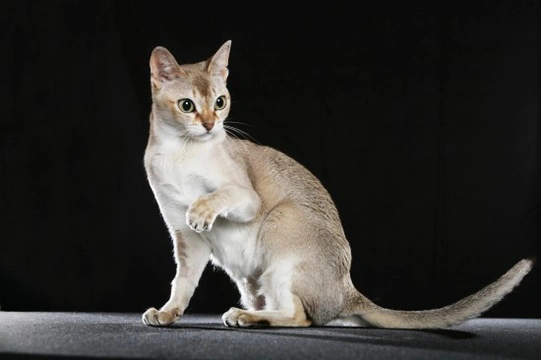
Some more information on the Singapura cat breed
The Singapura is a small breed of cat that hails from Singapore, and is one of the smallest breeds in the world! They are distinctive thanks to their small size, combined with large eyes and ears, short, blunt tails and ticked brown coats. There is some controversy surrounding the origins of the breed, as they were initially reported to have originated with three native cats that were exported from Singapore in the 1970’s, but it was later found that the three original cats were actually Abyssinian cats that were originally imported to Singapore from America, before being exported back out!
The Singapura is petite but relatively stocky for their size, with females weighing up to 6lb and males up to 8lb. They have short, fine coats that can only be found in one colour, called sepia agouti, which is a type of ticked tabby pattern consisting of an ivory background colour with dark brown ticks.
Due to their petite size, warm, friendly natures and curious personalities, the Singapura cat can fairly be described as cute and appealing, and for this reason they are popular as pets all across the world. In this article, we will provide a little more information on the Singapura cat for potential owners. Read on to learn more.
The genetics of the Singapura cat
The Singapura cat originated in Singapore in the 1970’s, with foundations including the Abyssinian breed and various other crossings. The Singapura’s genetic background is relatively well known, containing both Abyssinian and Burmese components, and just six cats formed the foundation of the modern Singapura breed. Due to the small number of founding cats and their relatively recent creation, the Singapura is in fact recognised as the breed with the least genetic diversity within their gene pool, something that can potentially lead to a range of genetically inherited health problems within the breed.
The known lack of genetic diversity within the breed is something that many Singapura breeders are keen to address, and the possibility of permitting outcrossings with other breeds to strengthen the gene pool is something that has been carefully considered. However, most breeders prefer to widen the gene pool while staying within the breed type and avoiding outcrossing by means of importing Singapura cats from other areas of the world, which provides a wider gene pool.
Are Singapura cats generally healthy?
The Singapura is known to have elevated risk factors for certain health conditions, particularly a condition known as uterine inertia, which can lead to problems delivering a litter. Uterine inertia is caused by weak muscles within the uterus that make it very hard for affected cats to deliver their young naturally, which means that delivery has to be made by caesarean section. It is now known that one of the female foundation cats of the breed suffered from this condition, which has led to its prevalence within the gene pool.
Pyruvate kinase deficiency also affects a reasonable number of cats of the breed, which can lead to haemolytic anaemia. Symptoms include lethargy, poor appetite, diarrhoea, weight loss and problems maintaining condition, and in some cases, jaundice.
What is their temperament like?
The Singapura cat is very much a people pleaser, and they love having company. They will not thrive if left alone for long periods of time, and they like having lots of people around to play with! They get on well with children who know how to handle cats properly and when to leave them alone, but as they are small and ergo can easily become hurt with rough handling, may not be a good match for families with young children.
They like to have company, and generally get on well with other cats, and sometimes dogs.
They are fairly demanding in terms of their desire for attention, and don’t like to be ignored or left to their own devices! They enjoy playing and hunting, either for real or in play, and tend to retain a young outlook and like to stay active right into old age. They are fairly vocal and will soon let you know if they do not think that they are getting enough attention, and so can fairly be described as relatively high maintenance in terms of their need for entertainment and company.
Are they easy to find offered for sale?
The Singapura is bred by several breeders within the UK, but as a relatively modern breed, they are not found in great numbers here in Britain. Singapura breeders often operate a waiting list for their kittens, and particularly if you want a show quality cat rather than a simple pet, you may have to wait months or even years to find the right one! The Singapura is also relatively expensive compared to other pedigree cat breeds due to their relative rarity, and it is not uncommon for pet quality Singapura cats to change hands for upwards of £600 as average.



